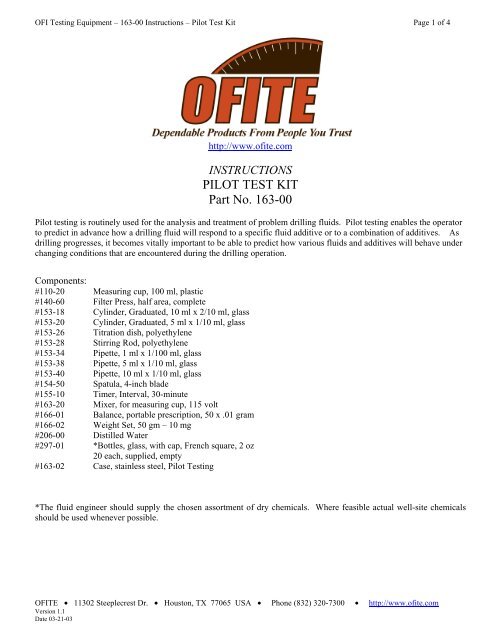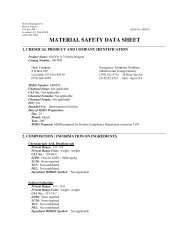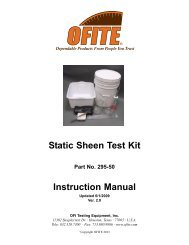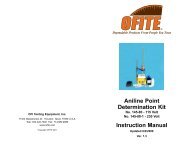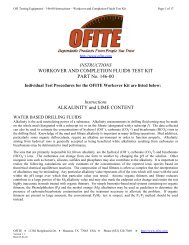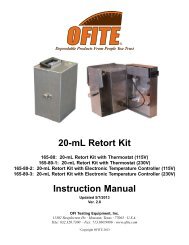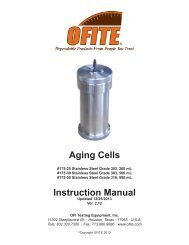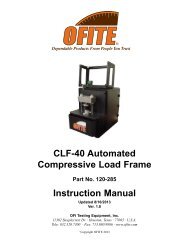Pilot Test Kit - OFI Testing Equipment, Inc.
Pilot Test Kit - OFI Testing Equipment, Inc.
Pilot Test Kit - OFI Testing Equipment, Inc.
Create successful ePaper yourself
Turn your PDF publications into a flip-book with our unique Google optimized e-Paper software.
<strong>OFI</strong> <strong>Test</strong>ing <strong>Equipment</strong> – 163-00 Instructions – <strong>Pilot</strong> <strong>Test</strong> <strong>Kit</strong> Page 1 of 4<br />
http://www.ofite.com<br />
INSTRUCTIONS<br />
PILOT TEST KIT<br />
Part No. 163-00<br />
<strong>Pilot</strong> testing is routinely used for the analysis and treatment of problem drilling fluids. <strong>Pilot</strong> testing enables the operator<br />
to predict in advance how a drilling fluid will respond to a specific fluid additive or to a combination of additives. As<br />
drilling progresses, it becomes vitally important to be able to predict how various fluids and additives will behave under<br />
changing conditions that are encountered during the drilling operation.<br />
Components:<br />
#110-20 Measuring cup, 100 ml, plastic<br />
#140-60 Filter Press, half area, complete<br />
#153-18 Cylinder, Graduated, 10 ml x 2/10 ml, glass<br />
#153-20 Cylinder, Graduated, 5 ml x 1/10 ml, glass<br />
#153-26 Titration dish, polyethylene<br />
#153-28 Stirring Rod, polyethylene<br />
#153-34 Pipette, 1 ml x 1/100 ml, glass<br />
#153-38 Pipette, 5 ml x 1/10 ml, glass<br />
#153-40 Pipette, 10 ml x 1/10 ml, glass<br />
#154-50 Spatula, 4-inch blade<br />
#155-10 Timer, Interval, 30-minute<br />
#163-20 Mixer, for measuring cup, 115 volt<br />
#166-01 Balance, portable prescription, 50 x .01 gram<br />
#166-02 Weight Set, 50 gm – 10 mg<br />
#206-00 Distilled Water<br />
#297-01 *Bottles, glass, with cap, French square, 2 oz<br />
20 each, supplied, empty<br />
#163-02 Case, stainless steel, <strong>Pilot</strong> <strong>Test</strong>ing<br />
*The fluid engineer should supply the chosen assortment of dry chemicals. Where feasible actual well-site chemicals<br />
should be used whenever possible.<br />
<strong>OFI</strong>TE • 11302 Steeplecrest Dr. • Houston, TX 77065 USA • Phone (832) 320-7300 • http://www.ofite.com<br />
Version 1.1<br />
Date 03-21-03
<strong>OFI</strong> <strong>Test</strong>ing <strong>Equipment</strong> – 163-00 Instructions – <strong>Pilot</strong> <strong>Test</strong> <strong>Kit</strong> Page 2 of 4<br />
Accessories:<br />
#Specify<br />
#Specify<br />
Roller Oven, portable, or laboratory model, for usage with high temperature wells<br />
High Temperature High Pressure Filter Press, for usage on high temperature wells and on all<br />
operations where oil muds are used.<br />
Procedure:<br />
<strong>Pilot</strong> testing uses equivalent volumes for analysis where a small liquid volume is considered equal to an actual volume<br />
of liquid used in the field. A 1 ml (1 cm 3 ) of liquid volume is approximately equivalent to 1 gram. The 5 ml<br />
graduated cylinder may be used for this determination. For greater accuracy, the actual weight of the fluid inside the<br />
cylinder may be measured. Using the balance, first weigh the empty graduate cylinder and then determine the weight of<br />
the cylinder with 1 ml of fluid. The difference in the two weights will determine the weight of the fluid.<br />
A convenient liquid volume used for each “response to additive” evaluation is 350 mls (350 cm 3 ). For pilot testing, one<br />
(1) gram per 350 mls of liquid is equivalent to one (1) pound per barrel, with a barrel equaling 42 gallons.<br />
. 1 gm / 350 mls = 1 lb m / bbl (Where 1 bbl = 42 gal.)<br />
lbm/bbl x 2.853 = kg/m3<br />
This is normally an adequate volume to run pilot testing after the sample has been prepared. The sample should be<br />
thoroughly mixed before removing each 350 ml portion from the larger sample. Separation of the components of a<br />
fluid sample between tests will cause erroneous test results.<br />
The sample to be evaluated should be taken from the suction pit before any chemical additions are added. A one gallon<br />
sample will normally be sufficient for a comprehensive fluid analysis, as several tests are usually required in order to<br />
determine the most economical and effective treatment. It is important to use the same fluid as the base when a group<br />
of tests are being run and the results of various additives are being compared.<br />
<strong>OFI</strong>TE • 11302 Steeplecrest Dr. • Houston, TX 77065 USA • Phone (832) 320-7300 • http://www.ofite.com<br />
Version 1.1<br />
Date 03-21-03
<strong>OFI</strong> <strong>Test</strong>ing <strong>Equipment</strong> – 163-00 Instructions – <strong>Pilot</strong> <strong>Test</strong> <strong>Kit</strong> Page 3 of 4<br />
<strong>Pilot</strong> <strong>Test</strong>ing Liquid Volumes<br />
1 gal. = 8.33 lb m<br />
1 lb m = 1 gm<br />
1 gm = 1 cm 3<br />
8.33 cm 3 = 8.33 gm = 1 gal.<br />
<strong>Pilot</strong> <strong>Test</strong>ing Conversion Factors (1 g/350 mls = 1 b m /bbl)<br />
lb m /bbl g in 100 mls g in 500 mls<br />
1.0 0.286 1.428<br />
2.0 0.571 2.857<br />
3.0 0.857 4.286<br />
3.5 1.000 5.000<br />
4.0 1.143 5.714<br />
5.0 1.428 7.140<br />
6.0 1.714 8.571<br />
7.0 2.000 10.000<br />
8.0 2.286 11.428<br />
9.0 2.571 12.856<br />
10.0 2.857 14.286<br />
<strong>Pilot</strong> <strong>Test</strong>ing Treating Solutions<br />
1 ml of 10% solution in 175 mls fluid = 0.2 lb m /bbl (0.57 kg/m3)<br />
1 ml of 10% solution in 350 mls fluid = 0.1 lb m /bbl (0.28 kg/m3)<br />
1 ml of 5% solution in 175 mls fluid = 0.1 lb m /bbl (0.28 kg/m3)<br />
1 ml of 5% solution in 350 mls fluid = 0.05 lb m /bbl (0.14 kg/m3)<br />
<strong>OFI</strong>TE • 11302 Steeplecrest Dr. • Houston, TX 77065 USA • Phone (832) 320-7300 • http://www.ofite.com<br />
Version 1.1<br />
Date 03-21-03
<strong>OFI</strong> <strong>Test</strong>ing <strong>Equipment</strong> – 163-00 Instructions – <strong>Pilot</strong> <strong>Test</strong> <strong>Kit</strong> Page 4 of 4<br />
Procedure:<br />
In order to produce results that will reveal changes to the fluid in only one variable, several procedures must be strictly<br />
adhered to. The most important ones are as follows.<br />
1. Time and Shear:<br />
A. The mixing device should be operated at the same speed for the entire set of tests. This is<br />
especially important for variable speed mixers.<br />
B. The mixing time should remain constant throughout the test.<br />
C. The base fluid (or blank) should be subjected to the same shear and mixing time prior to the test.<br />
This will eliminate any confusion about whether the results are due to shear or to treatment.<br />
D. In some cases the evaluation of a combination of products is needed. When this occurs, always<br />
use another sample of the base fluid. Sequential product additions to the same sample can lead to<br />
erroneous results because of extended mixing times and volume depletions.<br />
2 Additives:<br />
A. All additives (solids or liquids) should be carefully weighed or measured (liquids) prior to<br />
using them in the respective fluid samples. Number the samples and record the quantity of<br />
additions in each. To improve the homogeneity of the test samples, any additions should be<br />
made while the fluid is being stirred.<br />
B. Care should be taken in testing polymers, thinners or filtration control agents to evaluate only<br />
at temperatures that have thermal stability at or below estimated bottom hole temperature<br />
conditions.<br />
C. Whenever possible, use additives that are stocked on location for pilot testing.<br />
3 Sample Dilution:<br />
E. If water or oil dilution is necessary in a weighted fluid, the sample should be restored to its<br />
original density prior to testing. This will more accurately reflect the true effects of dilution.<br />
8.3 mls is the equivalent of 1 gallon of dilution per barrel of fluid.<br />
4 Time and Temperature:<br />
F. Measure the test sample properties as soon as possible after stirring. A time delay between<br />
mixing and testing can affect the rheological and filtration properties of the fluid. If a time<br />
delay cannot be avoided try to maintain the same time lapse for each sample.<br />
G. The test temperature can also affect fluid properties, therefore it is important to maintain the<br />
temperature as constant as possible for all samples. Thermal heat cups should be used when<br />
testing for viscosity under elevated temperature conditions.<br />
H. More accurate results may be obtained if the samples can be hot-rolled at 150ºF for<br />
approximately 3 or more hours prior to testing, if time permits and a roller oven is available.<br />
<strong>OFI</strong>TE • 11302 Steeplecrest Dr. • Houston, TX 77065 USA • Phone (832) 320-7300 • http://www.ofite.com<br />
Version 1.1<br />
Date 03-21-03


